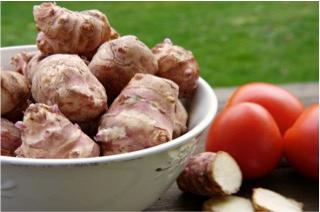Sunchoke or Jerusalem Artichoke
-
Scientific NameHelianthus tuberosus
-
General InformationSunchokes, also called Jerusalem artichokes, are productive, pest-free summer perennial tubers. Plants grow 10 to 12 feet tall. They are easy to grow. Taste is like a cross between an artichoke and a water chestnut. Sunchokes are native to North America and a relative of the sunflower.
 Photo: pxhere
Photo: pxhere -
When to Plant
Plant as soon as danger of frost has passed depending upon microclimate between mid-February through April. Sunchokes need at least 125 days to produce mature vegetables.
-
Planting
Sunchokes prefer a sunny location. They will reach for the sun if planted in partial shade.
Purchase tubers from mail order seed companies or plant sunchokes from the grocery store as long as buds are still intact. Choose firm, unblemished tubers. Cut very large tubers into sections that each have two or more buds and are at least one and a half inches in diameter.
Sunchokes spread unless you harvest every tiny piece of tuber in the fall, so container growing is a smart choice.
In the ground: Plant two inches deep and one foot apart.
In container: Use minimum five gallon pot. Plant four to six inches deep. Place pot into ground up to one-third its depth to give the plant stability as it can become quite tall (10 to 12 feet).
-
Soil Requirements
Sunchokes will grow in relatively infertile soil, but it's best to amend with compost. There is some evidence of better production in slightly alkaline soils. Heavy clay soils can cause smaller, misshapen tubers. For containers, a 50/50 mix of native soil and compost is preferred.
-
Water Requirements
In the ground, water well all summer.
In containers, water deeply once a week in summer.
-
Fertilizing
No fertilizer necessary.
-
Pollination
Pollination is not necessary. Small two inch flowers are a bonus, but do not always appear and are not necessary for tuber production.
-
Harvesting
Plant will begin to die back in October when the first tubers can be harvested.
What you don’t immediately need will keep best in the ground, and the flavor will become sweeter with some frost. Harvest what’s left by March, then choose and plant tubers for the next year’s crop.
-
Storage
Stores best in the ground but will keep in a plastic bag in the crisper section of the refrigerator for up to three weeks.
-
Good Varieties for Marin
‘Stampede’ is a knobby type that is extra early.
‘Fuseau’ has tubers four inches long and one inch in diameter.
‘Golden Nugget’ has small elongated tubers with a nutty flavor.
-
Helpful Tips
Though it will produce well in partial shade, it's more likely to flower with more sun.
Its prebiotic inulin fiber is prized for its value to the gut biome, but also cursed for causing gas in some cases. The inulin content is reduced when harvested after a frost, and can also be minimized with cooking. Moderate consumption to determine your own tolerance.
-
Common Problems
The most common problem is over-production, and not harvesting all tubers each year if planted in the ground. Do not place old tubers in the compost bin.
-
Pests- Diseases & More
Virtually pest-free.

